




















中国农业科技导报 ›› 2023, Vol. 25 ›› Issue (10): 152-164.DOI: 10.13304/j.nykjdb.2022.0121
• 动植物健康 • 上一篇
收稿日期:2022-02-23
接受日期:2022-05-07
出版日期:2023-10-15
发布日期:2023-10-27
通讯作者:
王萍
作者简介:郭航帆 E-mail 1049077469@qq.com;
Hangfan GUO1( ), Ping WANG1,2(
), Ping WANG1,2( ), Ying WANG3
), Ying WANG3
Received:2022-02-23
Accepted:2022-05-07
Online:2023-10-15
Published:2023-10-27
Contact:
Ping WANG
摘要:
为探究龙葵提取物对大肠杆菌、粪肠球菌的抑菌作用及其对生物膜形成的影响,比较了黑果龙葵、黄果龙葵、红果龙葵果及其茎叶提取物的抑菌能力,并对黑果龙葵果提取工艺进行响应面优化;通过结晶紫染色法测定黑果龙葵果提取物抑制细菌生物膜形成能力,以疏水性、泳动性、自聚集性为指标,评价提取物对生物膜形成的抑制作用。结果表明,3种龙葵中黑果龙葵果提取物抑菌效果最好,抑制大肠杆菌生长最佳提取条件为提取温度28 ℃、乙醇含量44.5%、液料比5.1∶1(mL·g-1),抑制粪肠球菌生长最佳提取条件为提取温度29.5 ℃,乙醇含量44.7%,液料比5.1∶1(mL·g-1),此时黑果龙葵果提取物对大肠杆菌、粪肠球菌的抑菌率分别为81.44%±1.78%、90.63%±2.33%,最小抑菌质量浓度均为50 mg·mL-1。30 mg·mL-1黑果龙葵果提取物对大肠杆菌、粪肠球菌生物膜形成的抑制率分别为83.52%、85.13%,提取物抑制大肠杆菌生物膜形成与降低疏水性显著相关(P<0.05),抑制粪肠球菌生物膜形成与降低泳动性、自聚集性显著相关(P<0.05)。上述结果可为龙葵抑菌和生物膜抑制提供理论依据,为开发天然植物抗生素替代品提供参考。
中图分类号:
郭航帆, 王萍, 王颖. 龙葵提取物对大肠杆菌、粪肠球菌及其生物膜形成的抑制作用[J]. 中国农业科技导报, 2023, 25(10): 152-164.
Hangfan GUO, Ping WANG, Ying WANG. Inhibitory Effect of Solanum nigrum L. Extracts on Escherichia coli and Enterococcus faecalis and Biofilm Formation[J]. Journal of Agricultural Science and Technology, 2023, 25(10): 152-164.
| 因素Factor | 水平 Level | ||
|---|---|---|---|
| -1 | 0 | 1 | |
| A:提取温度Temperature/℃ | 20 | 30 | 40 |
| B:乙醇含量Ethanol content/% | 40 | 45 | 50 |
| C:液料比Liquid-solid ratio/(mL·g-1) | 4∶1 | 5∶1 | 6∶1 |
表1 因素水平编码
Table 1 Factors and levels in the experimental design
| 因素Factor | 水平 Level | ||
|---|---|---|---|
| -1 | 0 | 1 | |
| A:提取温度Temperature/℃ | 20 | 30 | 40 |
| B:乙醇含量Ethanol content/% | 40 | 45 | 50 |
| C:液料比Liquid-solid ratio/(mL·g-1) | 4∶1 | 5∶1 | 6∶1 |
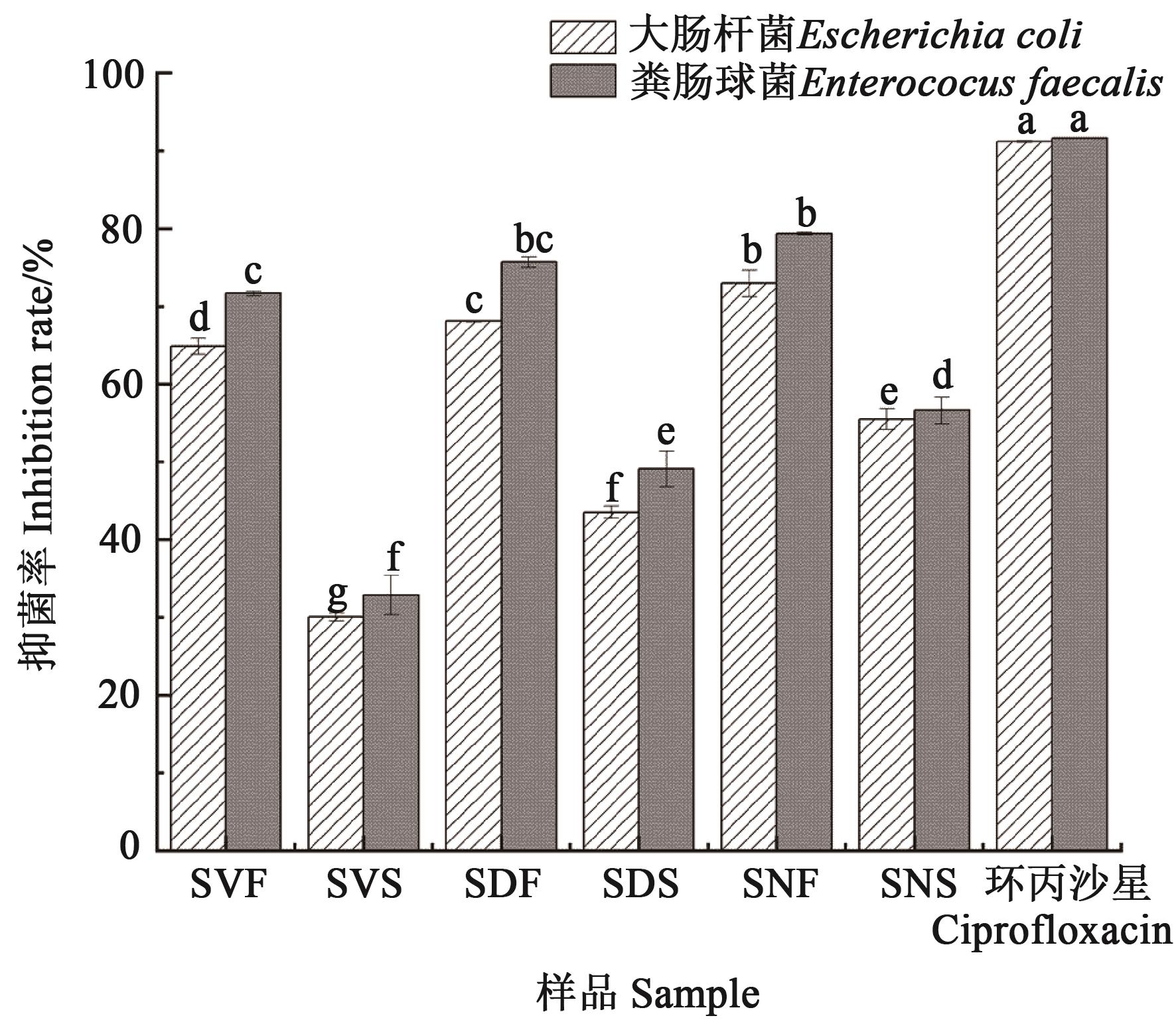
图1 龙葵不同部位提取物对大肠杆菌、粪肠球菌生长的抑制注:不同小写字母表示同一菌种不同处理间差异在P<0.05水平显著。
Fig. 1 Inhibition of extracts from different parts of Solanum nigrum L. on the growth of Escherichia coli and Enterococcus faecalisNote:Different lowercase letters indicate significant differences between different treatments of same bacteria at P<0.05 level.
| 样品Sample | 单宁Tannin | 皂苷Saponin | 蒽醌Anthraquinone | 甾醇 Sterol | 黄酮Flavone | 萜类Terpenoids | 生物碱Alkaloid | |
|---|---|---|---|---|---|---|---|---|
Wanger’s检测 Wanger’s test | Dragendorff’s检测 Dragendorff’s test | |||||||
| SNF | + | ++ | - | + | + | ++ | + | + |
| SNS | + | + | - | + | + | + | + | + |
| SDF | + | ++ | - | + | + | ++ | + | + |
| SDS | + | + | - | + | + | + | + | + |
| SVF | + | ++ | - | + | + | ++ | + | + |
| SVS | + | + | - | + | + | + | + | + |
表2 龙葵提取物活性成分
Table 2 Phytochemical screening of Solanum nigrum L. extract
| 样品Sample | 单宁Tannin | 皂苷Saponin | 蒽醌Anthraquinone | 甾醇 Sterol | 黄酮Flavone | 萜类Terpenoids | 生物碱Alkaloid | |
|---|---|---|---|---|---|---|---|---|
Wanger’s检测 Wanger’s test | Dragendorff’s检测 Dragendorff’s test | |||||||
| SNF | + | ++ | - | + | + | ++ | + | + |
| SNS | + | + | - | + | + | + | + | + |
| SDF | + | ++ | - | + | + | ++ | + | + |
| SDS | + | + | - | + | + | + | + | + |
| SVF | + | ++ | - | + | + | ++ | + | + |
| SVS | + | + | - | + | + | + | + | + |

图2 单因素试验结果注:不同小写字母表示同一菌种不同处理间差异在P<0.05水平显著。
Fig. 2 Results of single factor experimentsNote:Different lowercase letters indicate significant differences between different treatments of same bacteria at P<0.05 level.
| 试验编号 No. | A:提取温度Temperature | B:乙醇含量Ethanol content | C:液料比 Liquid-solid ratio | 抑制率Inhibition rate/% | |
|---|---|---|---|---|---|
Y1:大肠杆菌 Escherichia coli | Y2:粪肠球菌 Enterococcus faecalis | ||||
| 1 | 1 | 0 | 1 | 76.92±0.58 | 83.54±0.82 |
| 2 | 0 | 0 | 0 | 80.64±0.53 | 88.85±0.76 |
| 3 | 1 | -1 | 0 | 75.16±0.24 | 82.05±0.57 |
| 4 | -1 | -1 | 0 | 75.86±0.60 | 82.32±0.46 |
| 5 | 0 | 1 | -1 | 72.10±0.49 | 78.95±0.58 |
| 6 | -1 | 0 | 1 | 77.66±0.72 | 74.22±0.77 |
| 7 | 0 | 1 | 1 | 72.73±0.31 | 79.53±0.31 |
| 8 | 0 | 0 | 0 | 78.76±0.57 | 88.75±0.39 |
| 9 | 0 | -1 | 1 | 74.69±0.45 | 81.60±0.88 |
| 10 | -1 | 1 | 0 | 74.06±0.78 | 81.20±0.93 |
| 11 | 1 | 0 | -1 | 75.71±1.00 | 82.39±0.53 |
| 12 | 0 | 0 | 0 | 79.98±0.85 | 88.71±0.39 |
| 13 | -1 | 0 | -1 | 76.14±0.47 | 82.83±0.82 |
| 14 | 0 | 0 | 0 | 78.84±0.77 | 89.36±0.31 |
| 15 | 1 | 1 | 0 | 73.63±0.60 | 81.16±0.42 |
| 16 | 0 | -1 | -1 | 73.75±0.48 | 80.65±0.72 |
| 17 | 0 | 0 | 0 | 79.55±0.79 | 89.09±0.57 |
表3 Box-Behnken设计方案及结果
Table 3 Programs and experiment results of the Box-Behnken design
| 试验编号 No. | A:提取温度Temperature | B:乙醇含量Ethanol content | C:液料比 Liquid-solid ratio | 抑制率Inhibition rate/% | |
|---|---|---|---|---|---|
Y1:大肠杆菌 Escherichia coli | Y2:粪肠球菌 Enterococcus faecalis | ||||
| 1 | 1 | 0 | 1 | 76.92±0.58 | 83.54±0.82 |
| 2 | 0 | 0 | 0 | 80.64±0.53 | 88.85±0.76 |
| 3 | 1 | -1 | 0 | 75.16±0.24 | 82.05±0.57 |
| 4 | -1 | -1 | 0 | 75.86±0.60 | 82.32±0.46 |
| 5 | 0 | 1 | -1 | 72.10±0.49 | 78.95±0.58 |
| 6 | -1 | 0 | 1 | 77.66±0.72 | 74.22±0.77 |
| 7 | 0 | 1 | 1 | 72.73±0.31 | 79.53±0.31 |
| 8 | 0 | 0 | 0 | 78.76±0.57 | 88.75±0.39 |
| 9 | 0 | -1 | 1 | 74.69±0.45 | 81.60±0.88 |
| 10 | -1 | 1 | 0 | 74.06±0.78 | 81.20±0.93 |
| 11 | 1 | 0 | -1 | 75.71±1.00 | 82.39±0.53 |
| 12 | 0 | 0 | 0 | 79.98±0.85 | 88.71±0.39 |
| 13 | -1 | 0 | -1 | 76.14±0.47 | 82.83±0.82 |
| 14 | 0 | 0 | 0 | 78.84±0.77 | 89.36±0.31 |
| 15 | 1 | 1 | 0 | 73.63±0.60 | 81.16±0.42 |
| 16 | 0 | -1 | -1 | 73.75±0.48 | 80.65±0.72 |
| 17 | 0 | 0 | 0 | 79.55±0.79 | 89.09±0.57 |
方差来源 Variance source | 平方和 Sum of squares | 自由度 Degree of freedom | 均方 Mean square | F值 F value | P值 P value | 显著性 Significance |
|---|---|---|---|---|---|---|
| 模型Model | 108.440 | 9 | 12.050 | 31.480 | <0.000 1 | ** |
| A | 0.660 | 1 | 0.660 | 1.730 | 0.230 1 | NS |
| B | 6.020 | 1 | 6.020 | 15.730 | 0.005 4 | ** |
| C | 2.310 | 1 | 2.310 | 6.040 | 0.043 6 | * |
| AB | 0.018 | 1 | 0.018 | 0.048 | 0.833 5 | NS |
| AC | 0.024 | 1 | 0.024 | 0.063 | 0.809 4 | NS |
| BC | 0.024 | 1 | 0.024 | 0.063 | 0.809 4 | NS |
| A2 | 2.650 | 1 | 2.650 | 6.920 | 0.033 9 | * |
| B2 | 70.200 | 1 | 70.200 | 183.410 | <0.000 1 | ** |
| C2 | 19.520 | 1 | 19.520 | 51.000 | 0.000 2 | ** |
| 残差Residual | 2.680 | 7 | 0.380 | |||
| 失拟项Lack of fit | 0.180 | 3 | 0.059 | 0.095 | 0.958 8 | NS |
| 纯误差Pure error | 2.500 | 4 | 0.630 | |||
| 总和Total | 111.120 | 16 |
表4 大肠杆菌抑制率回归模型与方差分析
Table 4 ANOVA of the regression equation model of Escherichia coli inhibition rate
方差来源 Variance source | 平方和 Sum of squares | 自由度 Degree of freedom | 均方 Mean square | F值 F value | P值 P value | 显著性 Significance |
|---|---|---|---|---|---|---|
| 模型Model | 108.440 | 9 | 12.050 | 31.480 | <0.000 1 | ** |
| A | 0.660 | 1 | 0.660 | 1.730 | 0.230 1 | NS |
| B | 6.020 | 1 | 6.020 | 15.730 | 0.005 4 | ** |
| C | 2.310 | 1 | 2.310 | 6.040 | 0.043 6 | * |
| AB | 0.018 | 1 | 0.018 | 0.048 | 0.833 5 | NS |
| AC | 0.024 | 1 | 0.024 | 0.063 | 0.809 4 | NS |
| BC | 0.024 | 1 | 0.024 | 0.063 | 0.809 4 | NS |
| A2 | 2.650 | 1 | 2.650 | 6.920 | 0.033 9 | * |
| B2 | 70.200 | 1 | 70.200 | 183.410 | <0.000 1 | ** |
| C2 | 19.520 | 1 | 19.520 | 51.000 | 0.000 2 | ** |
| 残差Residual | 2.680 | 7 | 0.380 | |||
| 失拟项Lack of fit | 0.180 | 3 | 0.059 | 0.095 | 0.958 8 | NS |
| 纯误差Pure error | 2.500 | 4 | 0.630 | |||
| 总和Total | 111.120 | 16 |
方差来源 Variance source | 平方和 Sum of squares | 自由度 Degree of freedom | 均方 Mean square | F值 F value | P值 P value | 显著性 Significance |
|---|---|---|---|---|---|---|
| 模型Model | 209.990 | 9 | 23.330 | 197.910 | <0.000 1 | ** |
| A | 0.260 | 1 | 0.260 | 2.170 | 0.184 4 | NS |
| B | 4.030 | 1 | 4.030 | 34.210 | 0.000 6 | ** |
| C | 2.170 | 1 | 2.170 | 18.440 | 0.003 6 | ** |
| AB | 0.010 | 1 | 0.010 | 0.110 | 0.747 5 | NS |
| AC | 0.010 | 1 | 0.010 | 0.120 | 0.737 0 | NS |
| BC | 0.020 | 1 | 0.020 | 0.150 | 0.705 9 | NS |
| A2 | 18.850 | 1 | 18.850 | 159.910 | <0.000 1 | ** |
| B2 | 111.830 | 1 | 111.830 | 948.530 | <0.000 1 | ** |
| C2 | 54.300 | 1 | 54.300 | 460.550 | <0.000 1 | ** |
| 残差Residual | 0.830 | 7 | 0.120 | |||
| 失拟项Lack of fit | 0.530 | 3 | 0.180 | 2.390 | 0.209 2 | NS |
| 纯误差Pure error | 0.300 | 4 | 0.070 | |||
| 总和Total | 210.810 | 16 |
表5 粪肠球菌抑菌率回归模型与方差分析
Table 5 ANOVA of the regression equation model of Enterococcus faecalis inhibition rate
方差来源 Variance source | 平方和 Sum of squares | 自由度 Degree of freedom | 均方 Mean square | F值 F value | P值 P value | 显著性 Significance |
|---|---|---|---|---|---|---|
| 模型Model | 209.990 | 9 | 23.330 | 197.910 | <0.000 1 | ** |
| A | 0.260 | 1 | 0.260 | 2.170 | 0.184 4 | NS |
| B | 4.030 | 1 | 4.030 | 34.210 | 0.000 6 | ** |
| C | 2.170 | 1 | 2.170 | 18.440 | 0.003 6 | ** |
| AB | 0.010 | 1 | 0.010 | 0.110 | 0.747 5 | NS |
| AC | 0.010 | 1 | 0.010 | 0.120 | 0.737 0 | NS |
| BC | 0.020 | 1 | 0.020 | 0.150 | 0.705 9 | NS |
| A2 | 18.850 | 1 | 18.850 | 159.910 | <0.000 1 | ** |
| B2 | 111.830 | 1 | 111.830 | 948.530 | <0.000 1 | ** |
| C2 | 54.300 | 1 | 54.300 | 460.550 | <0.000 1 | ** |
| 残差Residual | 0.830 | 7 | 0.120 | |||
| 失拟项Lack of fit | 0.530 | 3 | 0.180 | 2.390 | 0.209 2 | NS |
| 纯误差Pure error | 0.300 | 4 | 0.070 | |||
| 总和Total | 210.810 | 16 |
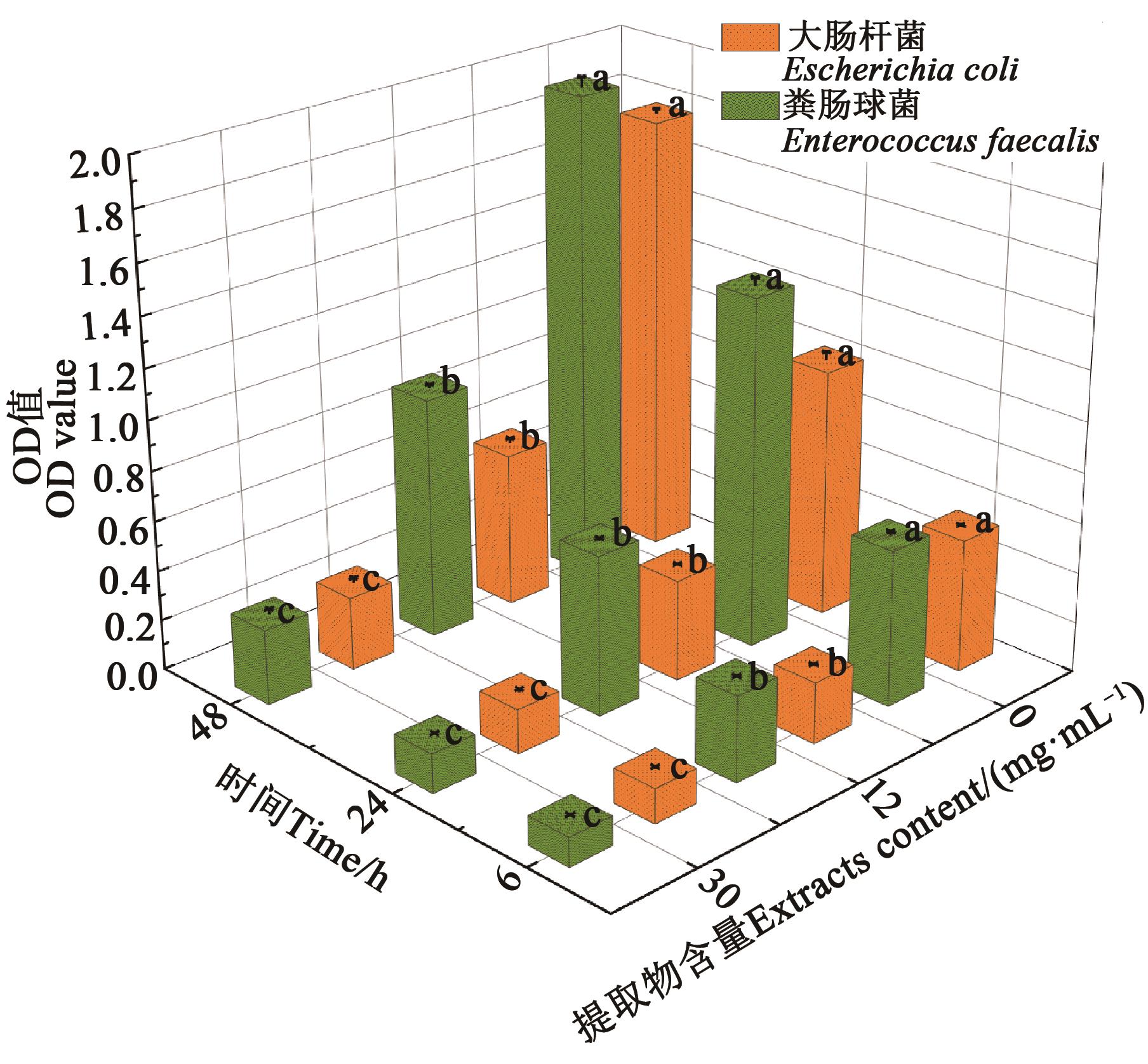
图5 黑果龙葵果提取物对细菌生物膜形成的影响注:不同小写字母表示同一时间同一菌种不同处理间差异在P<0.05水平显著。
Fig. 5 Effect of Solanum nigrum L. fruit extracts on bacterial biofilm formationNote:Different lowercase letters indicate significant differences between different treatments of same bacteria at same time at P<0.05 level.
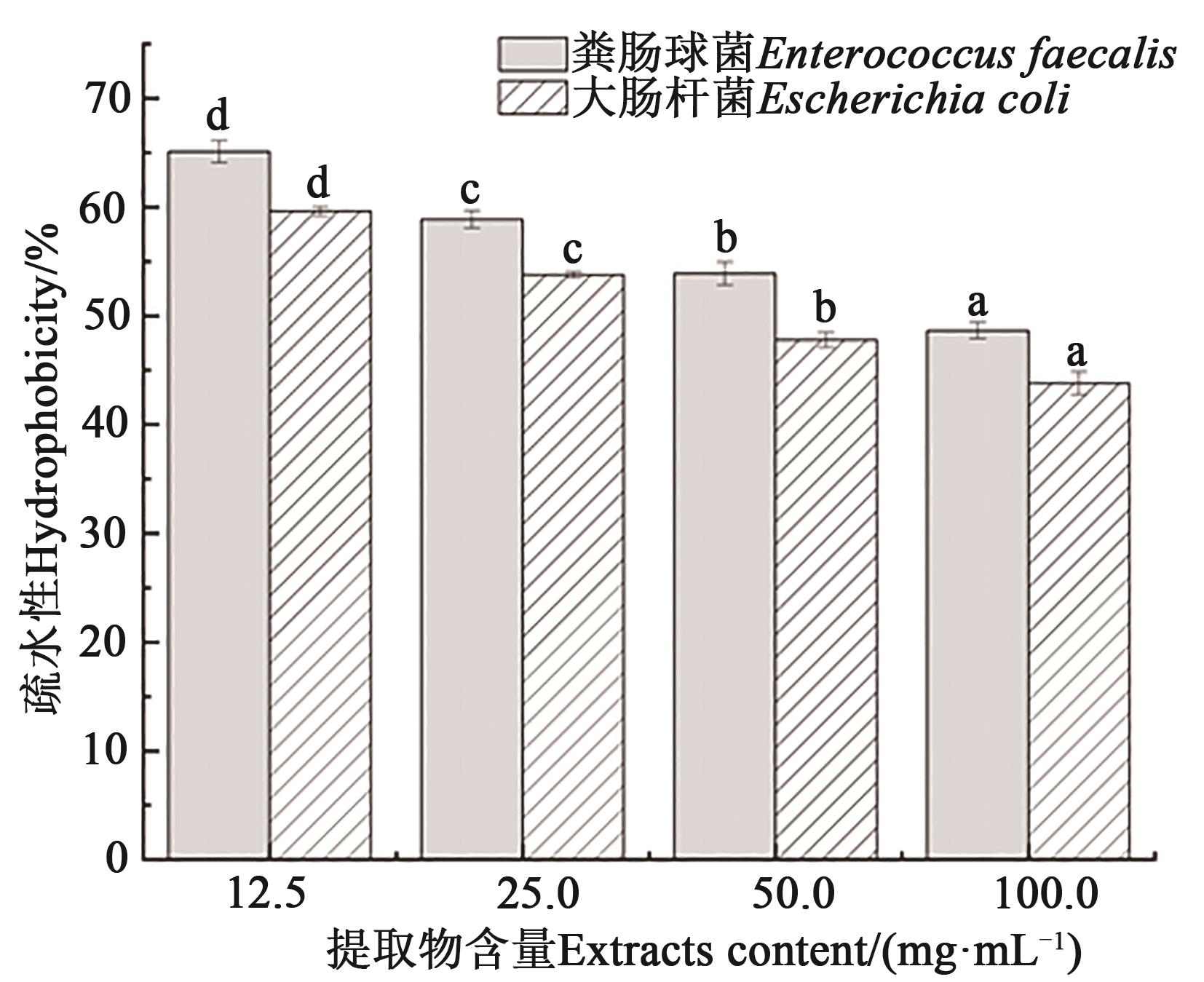
图6 黑果龙葵果提取物对细菌表面疏水性的影响注:不同小写字母表示同一菌种不同处理间差异在P<0.05水平显著。
Fig. 6 Effect of Solanum nigrum L. fruit extracts on hydrophobicityNote:Different lowercase letters indicate significant differences between different treatments of same bacteria at P < 0.05 level.
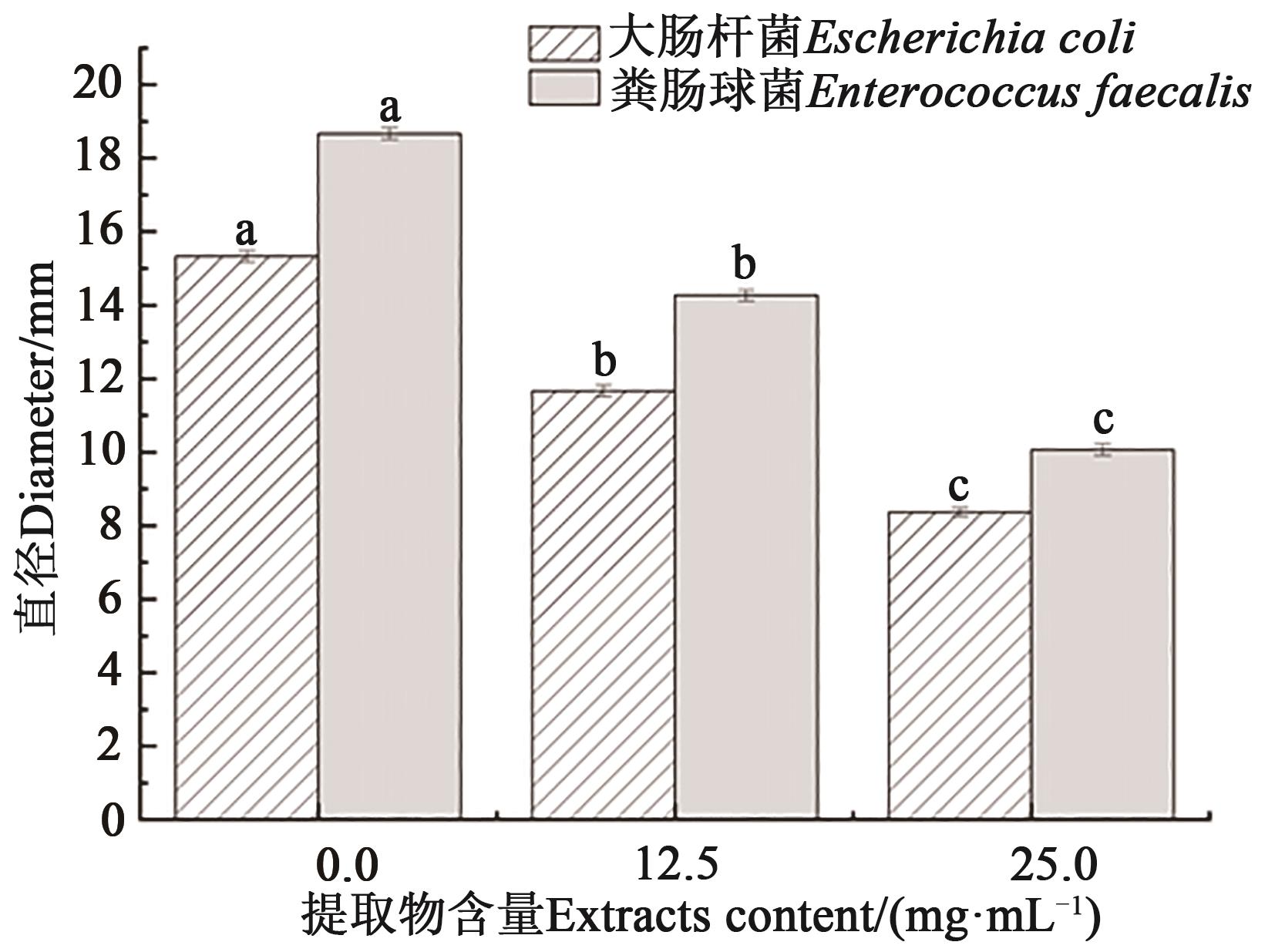
图7 黑果龙葵果提取物对细菌泳动性的影响注:不同小写字母表示同一菌种不同处理间差异在P<0.05水平显著。
Fig. 7 Effect of Solanum nigrum L. fruit extracts on swimmingNote:Different lowercase letters indicate significant differences between different treatments of same bacteria at P<0.05 level.
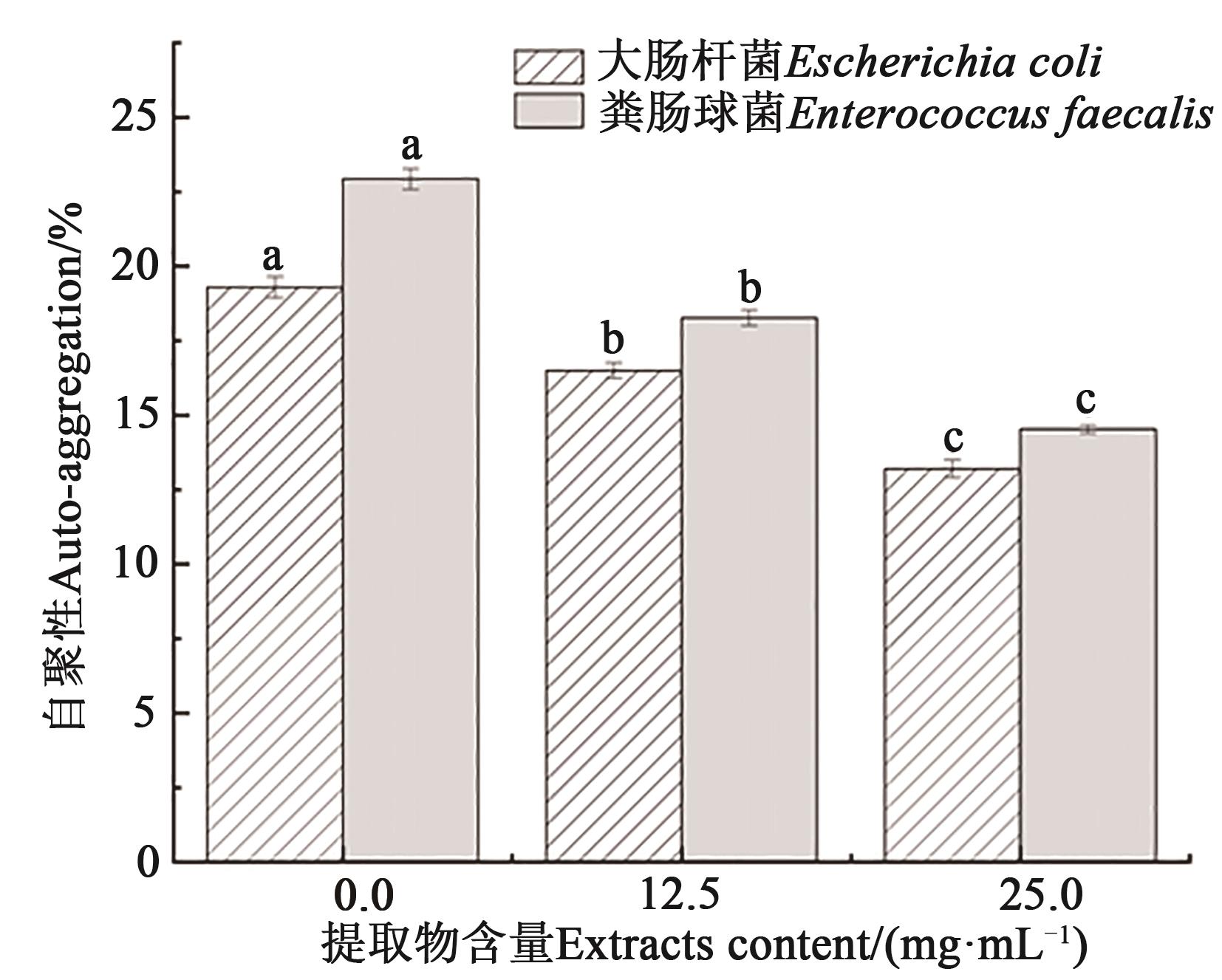
图8 黑果龙葵果提取物对细菌自聚集性的影响注:不同小写字母表示同一菌种不同处理间差异在P<0.05水平显著。
Fig. 8 Effect of Solanum nigrum L. fruit extracts on auto-aggregationNote:Different lowercase letters indicate significant differences between different treatments of same bacteria at P<0.05 level.
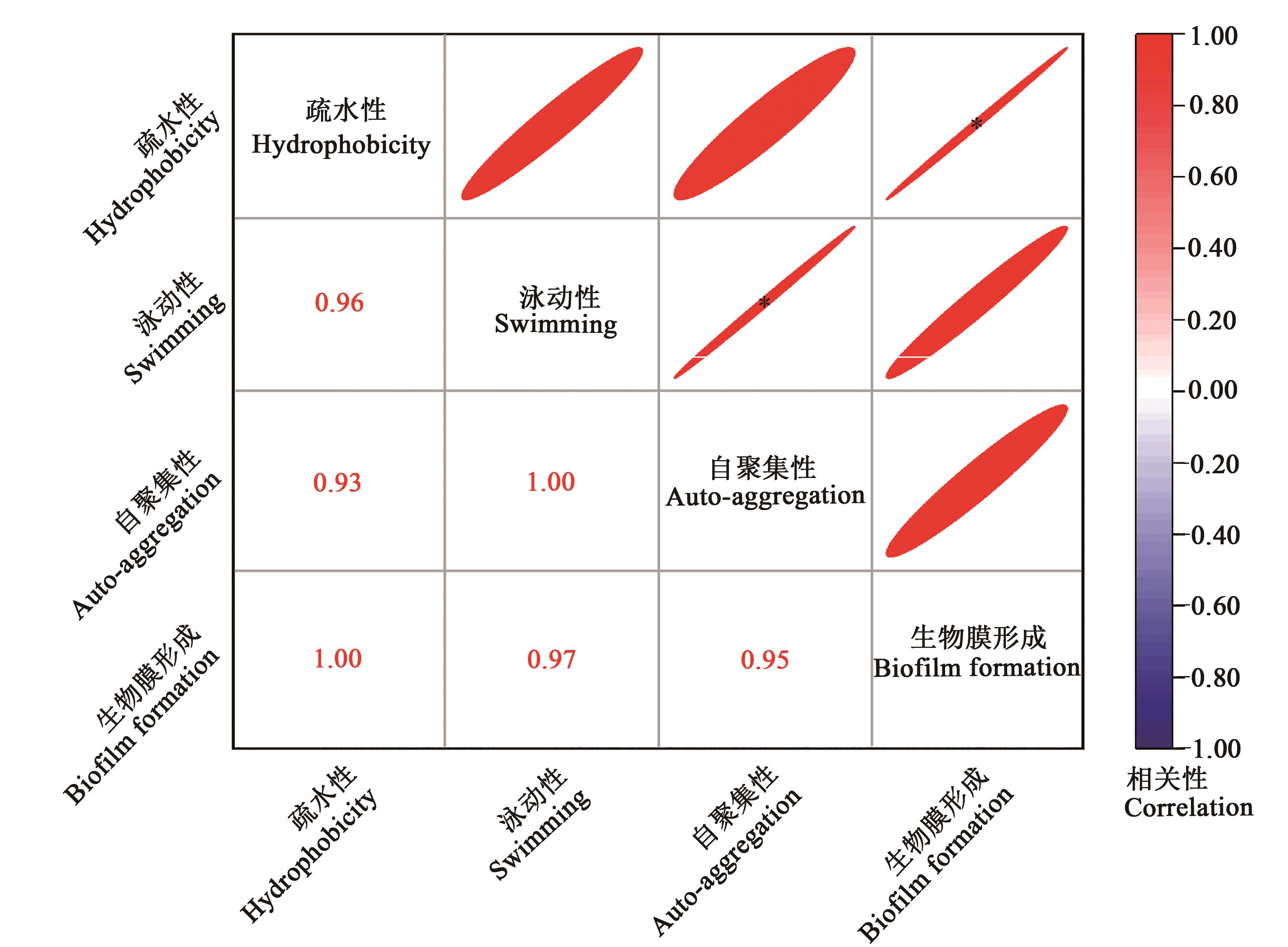
图9 大肠杆菌生物膜形成能力与细菌理化性质相关性分析注:*表示相关性在P<0.05水平显著。
Fig. 9 Correlation analysis between biofilm formation ability and physicochemical properties of Escherichia coliNote:* indicates significant correlation at P<0.05 level.

图10 粪肠球菌生物膜形成能力与细菌理化性质相关性分析注:*表示相关性在P<0.05水平显著。
Fig. 10 Correlation analysis between biofilm formation ability and physicochemical properties of Enterococcus faecalisNote: * indicates significant correlation at P< 0.05 level.
| 1 | 武喜红,李雪.《本草纲目》中茄科药物基源考证[J].亚太传统医药, 2018,14(11):85-86. |
| WU X H, LI X. Research on the medicinal base source of Solanaceae in Compendium of Materia Medica [J]. Asia-Pacific Traditional Med., 2018,14(11): 85-86. | |
| 2 | JABAMALAIRAJ A, PRIATAMA R A, HEO J, et al.. Medicinal metabolites with common biosynthetic pathways in Solanum nigrum [J]. Plant Biotechnol. Rep., 2019,13(4):315-327. |
| 3 | ILONDU E M, BOSAH B O. Fungicidal activity of Solanum nigrum and Physalis angulata extracts against Macrophomina phaseolina, a fruit rot pathogen of melon (Citrullus colocynthis (L.) Schrad [J]. J. Biopesticides, 2017,10(2):135-139. |
| 4 | CHESTER K, ZAHIREDDIN S, AHMAD A, et al.. Bioautography-based identification of antioxidant metabolites of Solanum nigrum L. and exploration its hepatoprotective potential against D-galactosamine-induced hepatic fibrosis in rats [J]. Pharmacogn Mag., 2019,15S(62):104-110. |
| 5 | ZAGHLOOL S S, ABO-SEIF A A, RABEH M A, et al.. Gastro-protective and anti-Oxidant potential of Althaea officinalis and Solanum nigrum on pyloric ligation/indomethacin-induced ulceration in rats [J/OL]. Antioxidants, 2019,8(11):512 [2022-01-22]. . |
| 6 | CHURIYAH C, NINGSIH S, FIRDAYANI F. The cytotoxic, apoptotic Induction, and cell cycle arrest activities of Solanum nigrum L. ethanolic extract on MCF-7 human breast cancer cell [J]. Asian Pac. J. Cancer Prev., 2020,21(12):3735-3741. |
| 7 | SHIN K, EUM Y. The antioxidant and antimicrobial activity of Solanum nigrum L. fruit powder by extraction solvent [J]. Korean J. Food Nutr., 2021,34(2):137-145. |
| 8 | YEOM Y, KIM M A, KIM J, et al.. Anti-inflammatory effects of the extract of Solanum nigrum L. on an acute ear edema mouse model [J]. Materials Technol., 2019,34(14):851-857. |
| 9 | KNAPP S, BARBOZA G E, SARKINEN T. Proposals to reject the name Solanum rubrum and to conserve the name S. alatum with a conserved type (Solanaceae) [J]. Taxon, 2017,66(4):988-989. |
| 10 | ABDEL-HAMID A E E, DINE R SEI, SENDKER J, et al.. Metabolic profiling of Solanum villosum Mill subsp. miniatum (Bernh. ex Willd.): hepatoprotective and antifibrotic activity in a rat model of liver fibrosis [J]. Pharmacogn. Mag., 2019,15(65):659-670. |
| 11 | HOSSAIN S J, EL-SAYED M A, MOHAMED A H, et al.. Phenolic content, anti-oxidative, anti-alpha-amylase and anti-alpha-glucosidase activities of Solanum diphylluml [J]. Bangladesh J. Bot., 2009,38(2):139-143. |
| 12 | THIEME L, HARTUNG A, TRAMM K, et al.. MBEC versus MBIC: the lack of differentiation between biofilm reducing and inhibitory effects as a current problem in biofilm methodology [J/OL]. Biol. Proced. Online, 2019,21(1):18 [2022-01-22]. . |
| 13 | DI MARCO N I, PAEZ P L, LUCERO-ESTRADA C S M, et al.. Naphthoquinones inhibit formation and viability of Yersinia enterocolitica biofilm [J/OL]. World J. Microbiol. Biotechnol., 2021,37(2):30 [2022-01-22]. . |
| 14 | CIOFU O, TOLKER-NIELSEN T. Tolerance and resistance of Pseudomonas aeruginosa biofilms to antimicrobial agents-how P. aeruginosa can escape antibiotics [J/OL]. Front. Microbiol., 2019,10:913 [2022-01-22]. . |
| 15 | MIZAN M F R, JAHID I K, KIM M, et al.. Variability in biofilm formation correlates with hydrophobicity and quorum sensing among Vibrio parahaemolyticus isolates from food contact surfaces and the distribution of the genes involved in biofilm formation [J]. Biofouling, 2016,32(4):497-509. |
| 16 | CALLE A F. Effect of anthocyanins in okinawan sweet potato on gowth and physicochemical properties of Salmonella typhimurium and Listeria monocytogenes [D]. Hawaii: University of Hawaii, 2020. |
| 17 | KHALEGHI M, KHORRAMI S. Down-regulation of biofilm-associated genes in mecA-positive methicillin-resistant S. aureus treated withM. communis extract and its antibacterial activity [J/OL]. AMB Express, 2021,11(1):85 [2022-01-22]. . |
| 18 | 梁兆超,郭显炜,宋艳娟,等.响应面法优化双孢蘑菇多糖提取工艺及其体外抗氧化活性研究[J].中国农业科技导报,2019,21(8):161-168. |
| LIANG Z C, GUO X W, SONG Y J, et al.. Extraction process of polysaccharide in Agaricus bisporus optimized by response surface method and its antioxidant activity in vitro [J]. J. Agric. Sci. Technol., 2019,21(8):161-168. | |
| 19 | 陈志迪,王新宇,李晴雯,等.植物源抑菌剂的研究进展[J].食品安全质量检测学报,2021,12(18):7433-7439. |
| CHEN Z D, WANG X Y, LI Q W, et al.. Research progress of plant-derived antimicrobial agents [J]. J. Food Saf. Qual.,2021,12(18):7433-7439. | |
| 20 | 张弘弛, 刘瑞, 柴帅, 等.恒山黄芪种子中抗菌肽提取条件的优化和抑菌率测定[J].食品科技,2021,46(3):212-219. |
| ZHANG H C, LIU R, CHAI S, et al.. Optimization of extraction conditions of antimicrobial peptides from Astragalus seeds and determination of antibacterial rate [J]. Food Sci. Technol., 2021,46(3): 212-219. | |
| 21 | MOURA D F D, ROCHA T A, BARROS D D M, et al.. Evaluation of the antioxidant, antibacterial, and antibiofilm activity of the sesquiterpene nerolidol [J]. Arch. Microbiol., 2021,203(7): 4303-4311. |
| 22 | INDHUMATHI T, MOHANDASS S. Efficacy of ethanolic extract of Solanum incanum fruit extract for its antimicrobial activity [J]. Int. J. Curr. Microbiol. Appl. Sci., 2014,3(6):939-949. |
| 23 | 李程程.牡丹花酚类成分提取纯化及其对大肠杆菌、金黄色葡萄球生物被膜抑制活性研究[D].无锡: 江南大学, 2020. |
| LI C C. Study on the extraction and purification of phenolics from peony flowers and their anti-biofilm activities of Escherichia coli and Staphylococcus aureus [D]. Wuxi: Jiangnan University, 2020. | |
| 24 | MAGNINI R D, NITIEMA M, OUEDRAOGO G G, et al.. Toxicity and bacterial anti-motility activities of the hydroethanolic extract of Acacia senegal (L.) Willd (Fabaceae) leaves [J/OL]. BMC Complementary Med. Ther., 2021,21(1): 178 [2022-01-22]. . |
| 25 | SALAHEEN S, JAISWAL E, JOO J, et al.. Bioactive extracts from berry byproducts on the pathogenicity of Salmonella Typhimurium [J]. Int. J. Food Microbiol., 2016,237:128-135. |
| 26 | PENESYAN A, PAULSEN I T, GILLINGS M R, et al.. Secondary effects of antibiotics on microbial biofilms [J/OL]. Front. Microbiol., 2020,11:2019 [2020-10-06]. . |
| 27 | KALAMARA M, ABBOTT J C, MACPHEE C E, et al.. Biofilm hydrophobicity in environmental isolates of Bacillus subtilis [J/OL]. Microbiology, 2021,167(9):441976 [2022-01-22]. . |
| 28 | COUVIGNY B, KULAKAUSKAS S, PONS N, et al.. Identification of new factors modulating adhesion abilities of the pioneer commensal bacterium Streptococcus salivarius [J/OL]. Front. Microbiol., 2018,9:273 [2022-01-22]. . |
| 29 | 张秋香,黄银,姚沛琳,等.植物乳杆菌FB-T9抑制变异链球菌及其生物膜形成的研究[J].食品与生物技术学报,2019,38(9):17-26. |
| ZHANG Q X, HUANG Y, YAO P L, et al.. Inhibition of Streptococcus mutans and its biofilm formation by Lactobacillus plantarum FB-T9 [J]. J. Food Sci. Biotechnol., 2019,38(9): 17-26. | |
| 30 | 姜春新,王雅莹,洪小利,等.柠檬酸和乙酸对致腐假单胞菌的抗生物被膜研究[J].核农学报,2021,35(1):120-127. |
| JIANG C X, WANG Y Y, HONG X L, et al.. Antibiofilm of citric acid and acetic acid against Spoilage related Pseudomonas [J]. Nucl. Agric. Sci., 2021,35(1): 120-127. | |
| 31 | 张荣先,仇博宇,赵佳,等.青刺果不同部位水提取液的抑菌效果[J].安徽农业科学,2007, 35(2):408-409, 411. |
| ZHANG R X, QIU B Y, ZHAO J, et al.. Effects of extracts from Prinsepia utilis royle on antimicrobial activity [J]. J. Anhui Agric. Sci., 2007,35(2): 408-409, 411. | |
| 32 | 姜雪琪,张卫东.龙葵超声波乙醇提取物抑菌作用研究[J].安徽农业科学,2016,44(31):125-155. |
| JIANG X Q, ZHANG W D. Study on antibacterial effect of ultrasonic ethanol extracts of Solanum nigrum [J]. J. Anhui Agric. Sci., 2016,44(31): 125-155. | |
| 33 | 张晶,邢媛媛,徐元庆,等.植物提取物活性成分的提取工艺及抑菌活性研究进展[J].动物营养学报,2019,31(12):5461-5467. |
| ZHANG J, XING Y Y, XU Y Q, et al.. Research progress on extraction technology and bacteriostatic activity of activeigredients in plant extracts [J]. Chin. J. Anim. Nutr., 2019,31(12):5461-5467. | |
| 34 | KALAISELVI I, RAJALAKSHMI P, PUSHPA S M, et al.. Enhanced bioaccessibility of green tea polyphenols and lipophilic activity of EGCG octaacetate on gram-negative bacteria [J]. LWT Food Sci. Technol., 2019,105:103-109. |
| 35 | MAMATOVA A S, KORONA-GLOWNIAK I, SKALICKA-WOZNIAK K, et al.. Phytochemical composition of wormwood (Artemisia gmelinii) extracts in respect of their antimicrobial activity [J/OL]. BMC Complementary Altern. Med., 2019,19(1):288 [2022-01-22]. . |
| 36 | YODA Y, HU Z Q, ZHAO W H, et al.. Different susceptibilities of Staphylococcus and Gram-negative rods to epigallocatechin gallate [J]. J. Infect. Chemother., 2004,10(1):55-58. |
| 37 | CHOI N, BAE Y, LEE S. Cell surface properties and biofilm formation of pathogenic bacteria [J]. Food Sci. Biotechnol., 2015,24(6):2257-2264. |
| 38 | LIU Y, HAN L, YANG H, et al.. Effect of apigenin on surface -associated characteristics and adherence of Streptococcus mutans [J]. Denal Materials J., 2020,39(6):933-940. |
| 39 | 萨仁高娃,胡文忠,冯可,等.植物精油及其成分对病原微生物抗菌机理的研究进展[J].食品科学, 2020,41(11):285-294. |
| Sarengaowa, HU W Z, FENG K, et al.. Antimicrobial mechanisms of essential oils and their components on pathogenic bacteria : a review [J]. Food Sci., 2020,41(11): 285-294. | |
| 40 | SONG Y J, YU H H, KIM Y J, et al.. Anti-biofilm activity of grapefruit seed extract against Staphylococcus aureus and Escherichia coli [J]. J. Microbiol. Biotechnol., 2019,29(8):1177-1183. |
| 41 | AFONINA I, LIM X N, TAN R, et al.. Planktonic interference and biofilm alliance between aggregation substance and endocarditis- and biofilm-associated pili in Enterococcus faecalis [J/OL]. J. Bacteriol., 2018,200(24):e00361 [2022-01-22]. . |
| 42 | 靳盼盼,刘亚文,邵美丽,等.香芹酚对食源粪肠球菌生物膜形成的抑制作用[J].中国食品学报, 2020,20(7):18-26. |
| JIN P P, LIU Y W, SHAO M L, et al.. Inhibition effect of carvacrol to biofilm formation of foodborne Enterococcus faecalis [J]. J. Chin. Inst. Food Sci. Technol., 2020,20(7): 18-26. | |
| 43 | LIU F, JIN P, GONG H, et al.. Antibacterial and antibiofilm activities of thyme oil against foodborne multiple antibiotics-resistant Enterococcus faecalis [J]. Poult. Sci., 2020,99(10):5127-5136. |
| [1] | 邵社刚, 李婷, 柳勇, 林兰稳, 张东, 倪栋, 李俊杰, 朱立安. 外源菌剂对稻秆腐解及微生物群落结构的影响[J]. 中国农业科技导报, 2023, 25(9): 166-177. |
| [2] | 肖锐, 谭璐, 吴亮, 张皓, 郭佳源, 杨海君. 镉胁迫下地肤根际与非根际土壤微生物群落结构及多样性[J]. 中国农业科技导报, 2023, 25(8): 203-215. |
| [3] | 尹兴盛, 包玲凤, 濮永瑜, 孙加利, 张庆, 李海平, 杨明英, 林跃平, 王怀鑫, 何永宏, 杨佩文. 减氮配施生物有机肥对植烟土壤特性及烟草青枯病的防效研究[J]. 中国农业科技导报, 2023, 25(7): 122-131. |
| [4] | 刘宏元, 周志花, 赵光昕, 沈钦瑞. 黄淮海平原农田土壤温室气体排放对长期施加生物炭的响应[J]. 中国农业科技导报, 2023, 25(7): 178-186. |
| [5] | 贺春萍, 樊兰艳, 吴贺, 梁艳琼, 吴伟怀, 李锐, 郑服丛. 枯草芽孢杆菌Czk1脂肽物质对橡胶树炭疽病和白粉病的抑制效果研究[J]. 中国农业科技导报, 2023, 25(6): 126-134. |
| [6] | 王旭东, 任雪冰, 汤舒, 郭琴, 薛梦瑶, 金鹏, 张云华. 污泥生物炭在土壤改良中的应用研究[J]. 中国农业科技导报, 2023, 25(6): 165-173. |
| [7] | 庞喆, 王启龙, 李娟. 不同土壤改良剂对陕北低洼盐碱地土壤理化性质及水稻产量和经济效益的影响[J]. 中国农业科技导报, 2023, 25(6): 174-180. |
| [8] | 孟璐, 范敬文, 赛欣娱, 曾路生, 宋祥云, 崔德杰. 石灰对苹果园土壤改良和植株生长的影响[J]. 中国农业科技导报, 2023, 25(4): 197-204. |
| [9] | 张豫丹, 王卫民, 倪博, 马晓寒, 李俊领, 许自成, 贾玮, 史久长. 烟草秸秆绿原酸提取工艺优化及其抑菌效果研究[J]. 中国农业科技导报, 2023, 25(1): 119-127. |
| [10] | 金辉, 王伟, 颜尘栋, 王薇, 李熙英. 水稻纹枯病生防木霉菌分离鉴定及适应性研究[J]. 中国农业科技导报, 2022, 24(9): 139-148. |
| [11] | 魏艳晨, 陈吉祥, 王永刚, 孟彤彤, 韩亚龙, 李美. 荒漠植物珍珠猪毛菜根际土壤细菌多样性与土壤理化性质相关性分析[J]. 中国农业科技导报, 2022, 24(5): 209-217. |
| [12] | 梁艳琼, 李锐, 吴伟怀, 习金根, 谭施北, 黄兴, 陆英, 贺春萍, 易克贤. 枯草芽孢杆菌Czk1挥发物混合活性组分对橡胶灵芝菌的抑菌机理[J]. 中国农业科技导报, 2022, 24(2): 152-159. |
| [13] | 李敏, 李钢铁, 张宏武, 陈家欢. 平茬对3种苗木来源蛋白桑林地土壤理化性质的影响[J]. 中国农业科技导报, 2022, 24(1): 172-182. |
| [14] | 周茂超1,2,黄艳娜2,段赛菲1,2,束仕元1,2,唐雪明2*. 微生物种衣剂的研制及其对玉米苗期生长的影响[J]. 中国农业科技导报, 2021, 23(4): 110-118. |
| [15] | 郁帆, 冯莹, 韩剑, 盛强, 孙丽英, 罗明, . 农用植物酵素液中梨树腐烂病菌拮抗细菌的筛选和防病效果[J]. 中国农业科技导报, 2021, 23(12): 125-135. |
| 阅读次数 | ||||||
|
全文 |
|
|||||
|
摘要 |
|
|||||
 京公网安备11010802021197号
京公网安备11010802021197号